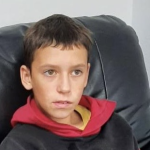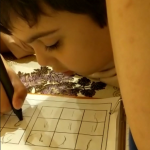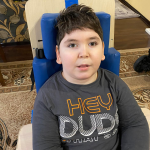Autistic Children and Television
The impact of television on autistic children is an extremely important issue for parents. Children with ASD face difficulties with socialization and lack the communication skills that are appropriate for their age. For this reason, they have limited opportunities for interaction with other children. Additionally, autistic children often have a very narrow range of interests, and they can spend hours engaging in the same activity. This often involves watching television or playing computer games. As a result, prolonged television watching hinders the child’s development of new social skills needed for interaction with peers. Furthermore, extended TV viewing disrupts the child’s peaceful and steady nighttime sleep.
Television and Phone – No More Than 1 Hour a Day
Child psychology experts recommend not introducing children to television or gadgets until they are at least 2 years old. After 2 years and up to the age of 6-7, the recommended time for video content viewing and gadget use should be limited to 1 hour per day. The same rules apply if the child has an autism spectrum disorder.
For children with ASD, watching television can also be beneficial. There are various educational programs designed to develop language skills and improve social interactions. For instance, programs with simple dialogues and visual aids help children learn to recognize emotions. There are also special gaming apps for phones that cater to children with autism.
What to Do If an Autistic Child Develops a Television Addiction?
If your child spends too much time in front of the screen or with gadgets, and any attempts to pull them away end in tantrums, your goal should be to limit screen time throughout the day and completely restrict gadget use before bed! How can you help your child overcome this dependency without tantrums?
Step 1: Plan a daily routine and get the child accustomed to it. Set specific times for television and gadget use.
Step 2: Come up with interesting activities, games, and creative tasks to distract the child from the desire to watch television.
Step 3: Set a timer to control the amount of time spent in front of the screen.
Step 4: Before bedtime, prioritize calming activities, such as reading books, drawing, or simply lying on the couch while listening to soothing music or sounds that don’t irritate the child’s sensory system.
In general, gadgets can be used beneficially for autistic children if time limits are adhered to and educational content is selected.
Corrective Therapy for Childhood Autism – Timely Development and Socialization
One of the newest methods of autism correction is stem cell transplantation. The Mardaleishvili Medical Center was one of the first to begin practicing such operations in Eastern Europe. More than ten years of practical experience and the unique expertise of the center’s specialists confirm the effectiveness of the procedure. Children from Europe, Asia, and even the USA visit the Mardaleishvili Center, despite the fact that stem cell transplantation originated in the USA.
The procedure itself is performed using minimally invasive techniques and does not require long-term rehabilitation. A patient with autism can receive stem cells from their half-sibling or from their own bone marrow or preserved umbilical cord blood. Results accumulate over time and become visible after several weeks. Children become more socialized, their speech develops, emotional spheres improve, and their ability to learn increases.
What should you know about the transplantation procedure? More information can be obtained from the consultants at the Mardaleishvili Center.
Autism Treatment Center Videos
Autism treatment with own stem cells
Cord blood association congress
International Quality Crown
Autism Treatment Reviews
Autism treatment with own stem cells
The story of Alessandro (6 years old)
Autism Patient Testimonial - Stem Cell Treatment
Clients Testimonials

Feedback from Igor, David’s father (12 years old) Read More

Feedback from Olga, Fedya’s mother Read More

Feedback from Natalia, Radomir’s mother (15 years old) Read More

Feedback from Esther, Samuel’s mother (8 years old) Read More

Feedback from Abibe, Selim’s mother (7 years old) Read More












